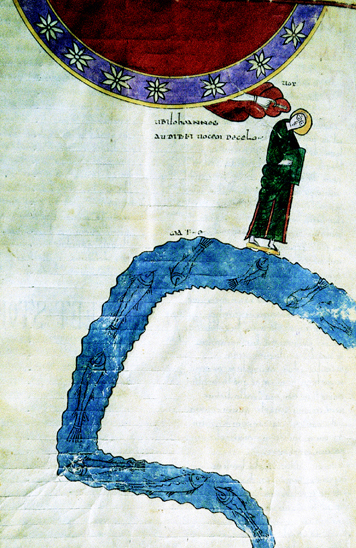
“When John heard a voice from heaven,” reads the Latin phrase in this tenth-century illustration from a commentary on the Book of Revelation. Compiled by the Spanish monk Beatus of Liebana (d. 798 A.D.), this commentary was one of the most frequently copied and illuminated manuscripts during the 10th and 11th centuries—an era when many Christians were caught up in a millennial fervor not unlike the one that surrounded the recent advent of the year 2000.
In this detail, the cloud-draped hand of God reaches out to John, the visionary author of Revelation, from a brightly colored disk that represents the celestial sphere. Beneath John’s feet is the island of Patmos, here depicted as little more than a golden wafer floating upon the waters of the Aegean Sea, which are teeming with fish. Though this depiction obviously heightens the isolation John must have felt as an exile on the island, Patmos is indeed quite small—about 10 miles long and 6 miles wide.
Standing with his head turned toward the outstretched hand, John seems poised for the impending moment when contact with the divine will unlock God’s hidden plan for the course of human history. Modern scholarship has, of course, done much to demystify John’s visionary book by drawing attention to parallel imagery and language in other apocalyptic writings from the ancient world and by matching John’s seemingly futuristic symbols with figures and events from his own day and age. Nevertheless, the image captured here, that of the isolated seer attuned to the voice of God, continues to dominate the popular conception of John’s experience on Patmos.
Already a library member? Log in here.
Institution user? Log in with your IP address.

